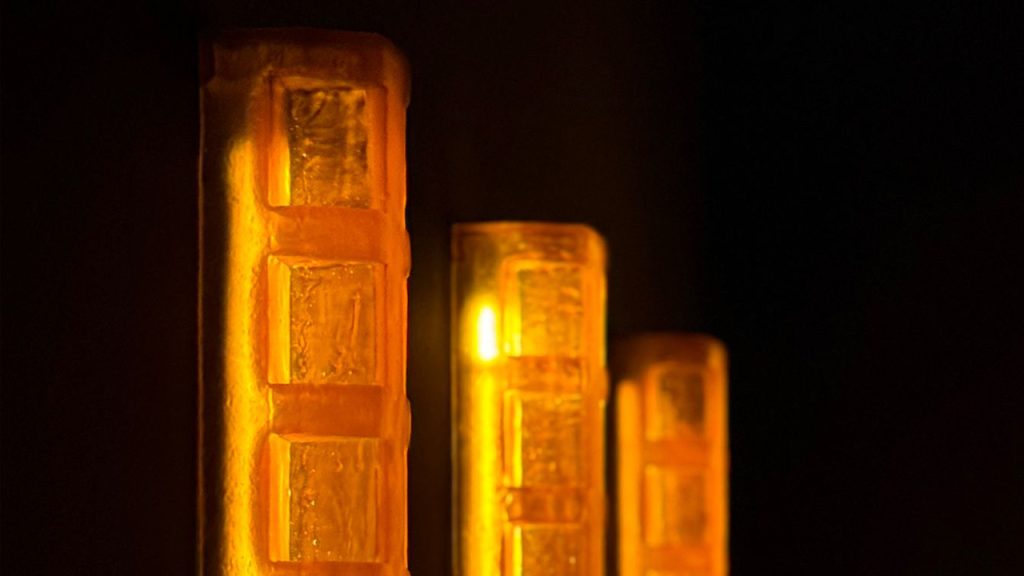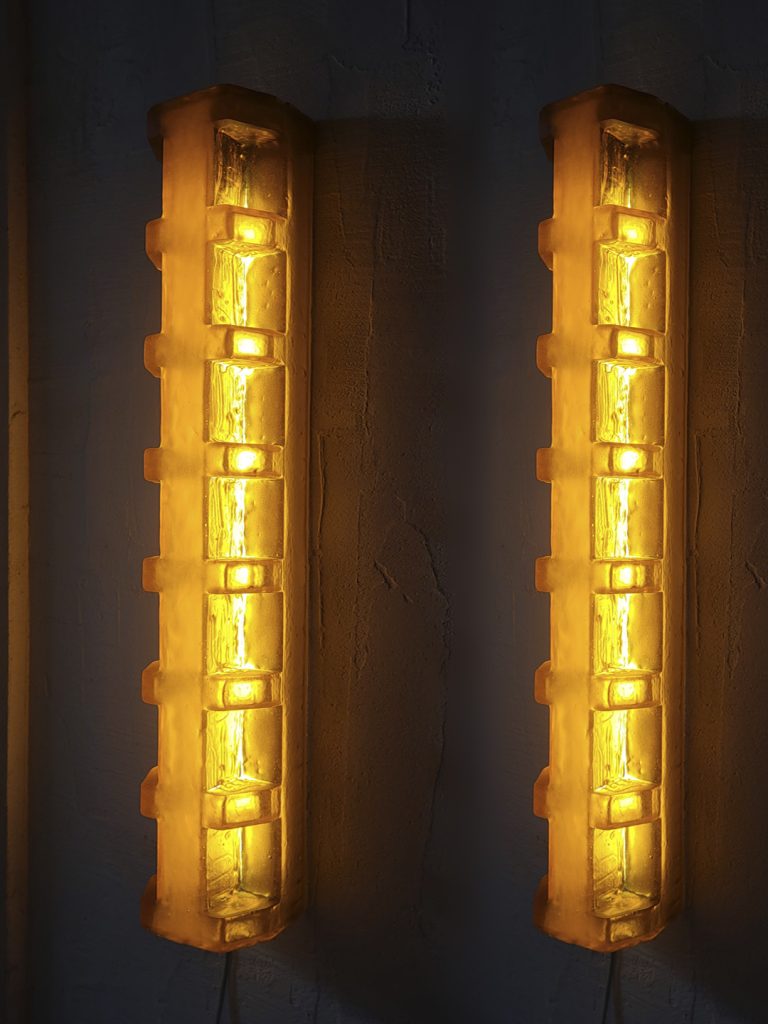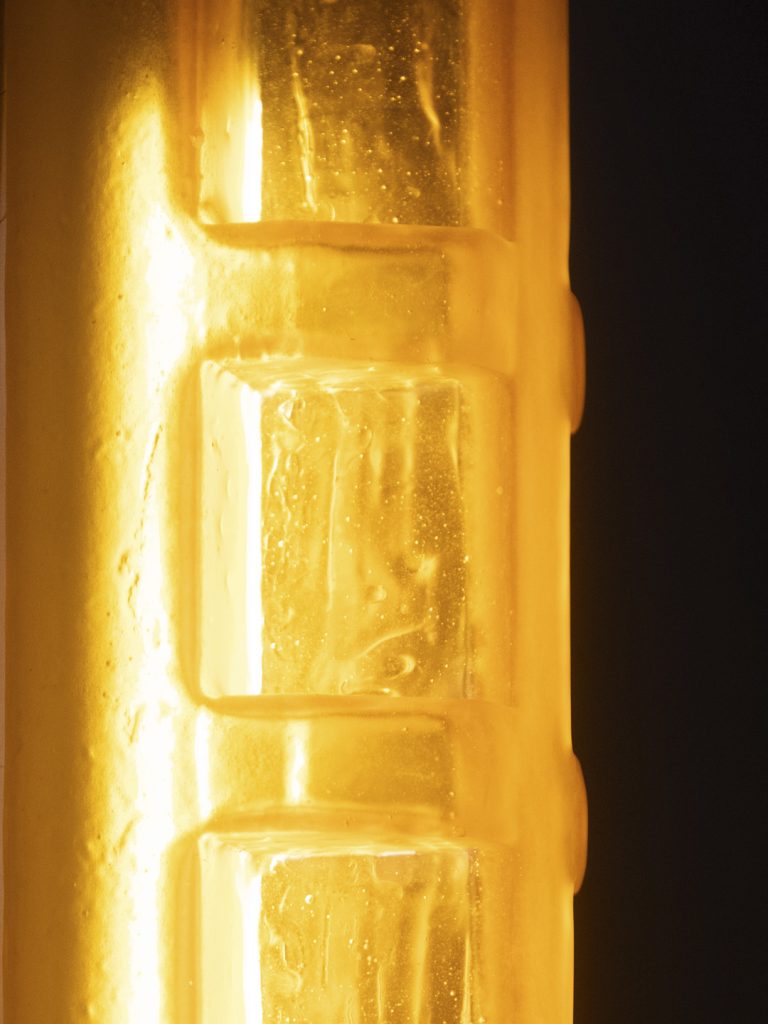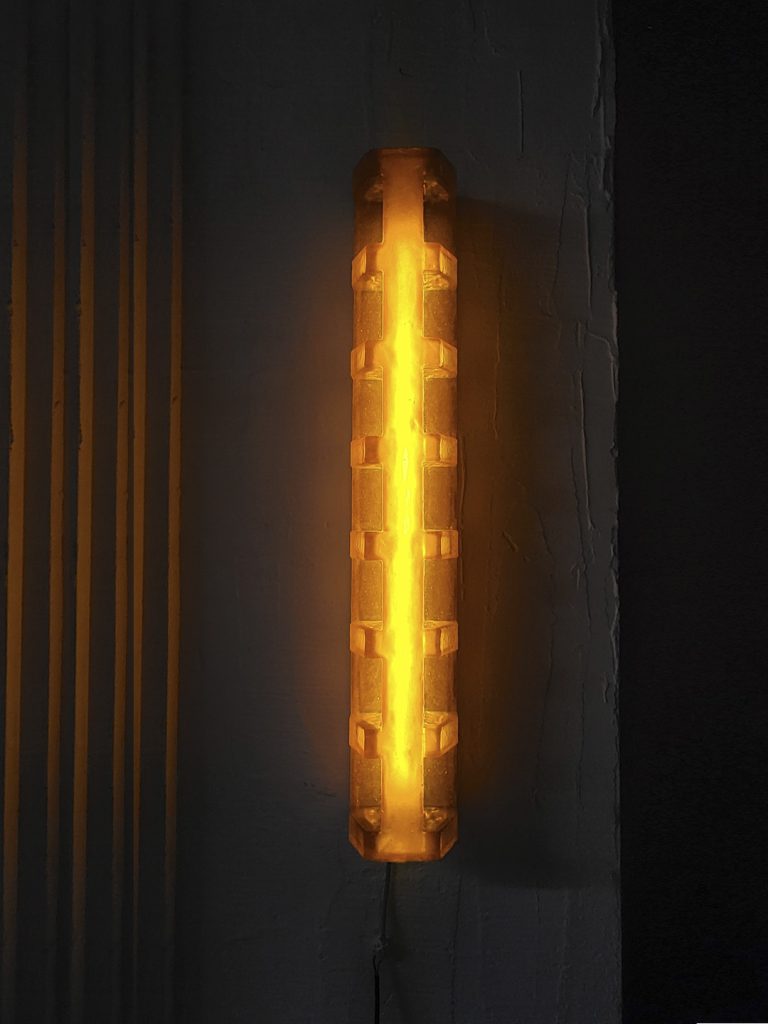Iteracion, serie 2025
The title of these pieces refers to repetition as a constructive principle — the way a minimal form can multiply and generate rhythm, sequence, and permanence. Each piece reiterates the same canon over and over: a geometric pattern, somewhere between column, totem, and signal, functioning as a luminous architecture.
In this series, light once again becomes the center of investigation, but approached from a more structural and architectural perspective. Conceived as modular bodies, the pieces explore the tension between industrial geometry and the organic vibration of matter. Light travels through their interior, revealing an incandescent axis that transforms the static volume into an active form, as if the inner energy had found a way to materialize.
In choosing the amber tone of the series, we wanted to evoke the memory of fossil resin or incandescent mineral — a matter suspended in time, the memory of a flame that no longer burns, a quality both warm and dense.
El título de estas piezas hace referencia a la repetición como principio constructivo, a la manera en que una forma mínima puede multiplicarse y generar ritmo, secuencia y permanencia. Cada pieza repite una y otra vez el mismo canon: un patrón geométrico, entre columna, tótem y señal, que funciona como una arquitectura luminosa.
En esta serie la luz vuelve a ser el centro de la investigación, pero abordada desde un lugar más estructural y arquitectónico. Las piezas, concebidas como cuerpos modulares, exploran la tensión entre la geometría industrial y la vibración orgánica de la materia. La luz atraviesa su interior y revela un eje incandescente que transforma el volumen estático en una forma activa, como si la energía interior encontrara un modo de materializarse.
En la elección del tono ámbar de la serie hemos querido traer al pensamiento el recuerdo de la resina fósil o de un mineral incandescente… Una materia que ha quedado atrapada en el tiempo, la memoria de una llama que ya no quema, una cualidad cálida y densa.

In Iteration, geometry acts as a structure in which spaces, grooves, and edges modulate the intensity of light, creating a dialogue between the precise and the eroded.
The matte, smooth surface reveals traces of the mold and the small irregularities of the process. Within them, the coldness of the technical and the vulnerability of the handmade coexist. It is an object that exists halfway between an archaeological finding and a piece of traditional contemporary production.
Each set is composed of two sculptures that behave as a pair or as a sequence; placed together or facing one another, the pieces activate a relationship between them, and it is in that dialogue where the idea of iteration becomes evident: repetition that generates difference, the form that reappears.
More than objects, the Iteration pieces function as signals, orientation devices within a landscape where light becomes a point of reference.
En Iteración, la geometría actúa como una estructura en la que los espacios, ranuras y aristas modulan la intensidad lumínica, generando un diálogo entre lo exacto y lo erosionado.
La superficie, mate y suave, deja ver las huellas del molde y las pequeñas irregularidades del proceso. En ellas se mezclan la frialdad de lo técnico y la vulnerabilidad de lo manual. Un objeto a medio camino entre el hallazgo arqueológico y la producción contemporánea tradicional.
Cada conjunto se compone de dos esculturas que se comportan como pareja o como secuencia; juntas o enfrentadas las piezas activan entre ellas una relación y es en ese diálogo donde se pone de manifiesto la idea de iteración: la repetición que genera diferencia, la forma que aparece otra vez.
Más que objetos, las piezas de Iteración funcionan como señales: dispositivos de orientación en un escenario donde la luz es una referencia.



Enlighted sculpture. Pieces created one by one using a unique manual process and lost-plaster mold.
Three pairs of pieces.
Iteration series: solid epoxi resin. Dimensions: 77 x 14 x 13 cm. Light LED.
Escultura iluminada. Piezas creadas una a una mediante un proceso manual único y por molde perdido.
Tres parejas de piezas.
Iteración, serie. Resina epoxi sólida. Dimensiones: 77 x 14 x 13 cm. Luz LED.
Layers, pauses, trace.
Each piece has been made using a lost-plaster mold process, as with many of our works.
Starting from an initial master, a plaster mold was created and filled layer by layer, generating internal textures within the resin.
The material was applied with a brush, slowly ascending, allowing each layer to cure during application so that it adhered properly to the vertical walls.
This long and repetitive process required returning again and again to the surface, building the resin upward as it hardened and leaving on the piece the imprints of the work in each layer.
Once completed, the plaster mold was manually broken after being moistened to facilitate extraction. The result preserves the marks of the process, the irregularities of drying time, and the memory of the manual work that gave it form.
Capas, pausas, huella.
Cada pieza ha sido realizada mediante un proceso de molde perdido, como muchas de nuestras piezas.
A partir de un máster inicial, se creó un molde de yeso que fue rellenado capa a capa, generando texturas interiores en la resina.
La aplicación del material se realizaba con pincel, ascendiendo lentamente, permitiendo que cada capa catalizara durante la aplicación para propiciar que quedase adherido a las paredes verticales.
Este proceso, largo y repetitivo, obligaba a volver una y otra vez sobre la superficie, subiendo la resina mientras se endurecía, y dejando impresas en la obra las huellas del trabajo en cada capa.
Una vez completada la pieza, el molde de yeso se rompía manualmente, tras humedecerlo para facilitar la extracción. El resultado conserva las marcas del proceso, las irregularidades del tiempo de secado y la memoria del trabajo manual que le dio forma.
Estas piezas fueron creadas para exposición individual La alquimia de la luz (4.10.25 – 21.11.25) en la Sala Negra de la galería Isolina Arbulú, Marbella.